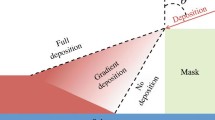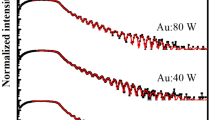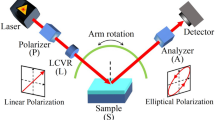Abstract
Physical vapor deposition (PVD) is one of the major methods for fabricating thin films. Measuring and controlling the thickness of deposited layers are very momentous, especially for optics and photonics applications. Despite regular depositions with substrates situated near the thickness monitor, the oblique angle deposition method requires applying a correction factor for estimating real thicknesses. In this paper, we establish a correction factor formula for different positions of the substrate relative to the deposition source. After numerical simulations, several samples with [Glass/Nickel] and [Glass/Nickel/Zinc Sulfide] structures are fabricated using an oblique angle PVD method. Magneto-optical Kerr measurements and hysteresis loop analysis are obtained from three different points of samples with different thicknesses and compared to the corresponding simulated structures. The results of the correction factor show a high degree of conformity with simulations. Cross-sectional field emission scanning electron microscopic characterization is also used to illustrate the thickness of samples. The thicknesses are then compared to the results obtained from the correction factor, confirming its reliability for practical use in oblique angle deposition methods.











Similar content being viewed by others
References
Moarrefzadeh, A.: Simulation and Modeling of Physical Vapor Deposition (PVD) Process. WSEAS Trans. Appl. Theor. Mech. 7, 106–111 (2012)
Savale, P.A.: Physical vapor deposition (PVD) methods for synthesis of thin films: a comparative study. Arch. Appl. Sci. Res. 8, 1–8 (2016)
Mattox, D.M.: Mattox. V.H, Vacuum coating technology. Springer (2003)
Pawlak, R., Korzeniewska, E., Koneczny, C., Hałgas, B.: Properties of thin metal layers deposited on textile composites by using the PVD method for textronic applications. Autex Res. J. 17, 229–237 (2017)
Li, Z., Li, Q., Quan, X., Zhang, X., Song, C., Yang, H., Wang, X., Gao, J.: Broadband high-reflection dielectric PVD coating with low stress and high adhesion on PMMA. Coatings. 9, 237 (2019). https://doi.org/10.3390/coatings9040243
Uribe, E., Salas, O., Melo-Maximo, D., Oseguera, J., Lepienski, C.M., Torres, R.D., Souza, R.M.: Development of Al oxide PVD coatings against metal dusting. Surf. Eng. 31, 114–122 (2015)
Boulard, B., Peron, O., Chiasera, A., Ferrari, M., Jestin, Y.: Application of PVD technique to the fabrication of erbium doped ZrF4-based glass ceramic for optical amplification. Proc. SPIE 6183, Integrated Optics, Silicon Photonics, and Photonic Integrated Circuits, 61831L (2006). https://doi.org/10.1117/12.662631
Gao, Y., Boulard, B., Couchaud, M., Vasilief, I., Guy, S., Duverger, C., Jacquier, B.: Preparation by PVD of Er/Ce-doped PZG fluoride glass channel waveguide for integrated optical amplifiers at 1.5 μm. Opt. Mater. (Amst). 28, 195–199 (2006)
Chen, J., Ku, T.C., Li, M.F., Chin, A.: Investigation of Schottky junction and MOS technology for 111-V compound semiconductor MOSFET application. 12th International Workshop on Junction Technology, Shanghai, 2012, pp. 127-130 (2012). https://doi.org/10.1109/IWJT.2012.6212826
Gall, S., Barreau, N., Harel, S., Bernède, J.C., Kessler, J.: Material analysis of PVD-grown indium sulphide buffer layers for Cu(In,Ga)Se2-based solar cells. Thin Solid Films. 480–481, 138–141 (2005). https://doi.org/10.1016/j.tsf.2004.11.017
Barreau, N., Marsillac, S., Bernede, J.C., Ben Nasrallah, T., Belgacem, S.: Optical properties of wide band gap indium sulphide thin films obtained by physical vapor deposition. Phys. Status Solidi. 184, 179–186 (2001)
Fu, J., Park, B., Siragusa, G., Jones, L., Tripp, R., Zhao, Y., Cho, Y.-J., et al.: Nanotechnology. 19, 155502 (2008). https://doi.org/10.1088/0957-4484/19/15/155502
Parlak, U., Akoz, M.E., Tokdemir Ozturk, S., Erkovan, M.: Thickness dependent magnetic properties of polycrystalline nickel thin films. Acta Phys. Pol. A. 127, 995–997 (2015)
Arkwright, J., Underhill, I., Pereira, N., Gros, M., Gross, M.: Deterministic control of thin film thickness in physical vapor deposition systems using a multi-aperture mask. Opt. Express. 13, 2731 (2005). https://doi.org/10.1364/opex.13.002731
Suh, D., Park, Y., Ryu, H., Sohn, Y.J., Paek, M.C.: Numerical characterization of the magneto-optical polar Kerr effect of a SiOx/FePt/SiOx/Al multilayer on glass substrate. J. Magn. Magn. Mater. 272–276, 2299–2300 (2004). https://doi.org/10.1016/j.jmmm.2003.12.934
Moradi, M., Ghanaatshoar, M.: Investigation of magneto-optical Kerr signal enhancement in amorphous magnetic ribbons. Eur. Phys. Journal-Applied Phys. 61, 10603-p1–10603-p3 (2013). https://doi.org/10.1051/epjap/2013120295
Zou, Z.Q., Liu, G.Q.: Magneto-optical Kerr effect of amorphous TbFeCoTa film with a quadrilayer structure. Appl. Phys. A Mater. Sci. Process. 78, 711–716 (2004). https://doi.org/10.1007/s00339-002-1984-5
Ghasemi, A.H.B., Faridi, E., Ansari, N., Mohseni, S.M.: Extraordinary magneto-optical Kerr effect via MoS 2 monolayer in Au/Py/MoS 2 plasmonic cavity. RSC Adv. 6, 106591–106599 (2016). https://doi.org/10.1039/C6RA21314F
Ghanaatshoar, M., Moradi, M., Tehranchi, M.M., Hamidi, S.M.: Magneto-optical Kerr effect in glass/Cu/CoFeSiB/SnO2 thin films. J. Non-Cryst. Solids. 354, 5266–5268 (2008)
Si, P., Mortensen, J., Komolov, A., Denborg, J., Moller, P.J.: Polymer coated quartz crystal microbalance sensors for detection of volatile organic compounds in gas mixtures. Anal. Chim. Acta. 597, 223–230 (2007). https://doi.org/10.1016/j.aca.2007.06.050
Sauerbrey, G.Z.: The use of quarts oscillators for weighing thin layers and for microweighing. Z. Phys. 155, 206–222 (1959)
Gaur, S.K., Mishra, R.S.: Thermal evaporation- modeling and microstructure studies of indium and tin deposition. Int. J. Adv. Res. Innov. 3, 207–215 (2015)
Esmaeilzadeh, B., Moradi, M., Jahantigh, F.: An investigation of magneto-optical Kerr effect signal by optical cavity in [Glass/Co/ZnS] structure. J. Magn. Magn. Mater. 460, 207–212 (2018). https://doi.org/10.1016/j.jmmm.2018.04.003
Mahmoodi, S., Moradi, M., Mohseni, S.M.: Optimization of magneto-optical Kerr effect in Cu/Fe/Cu Nano-structure. J. Supercond. Nov. Magn. 29, 1517–1523 (2016). https://doi.org/10.1007/s10948-016-3432-3
Ayareh, Z., Moradi, M., Mahmoodi, S.: Tuning the effective parameters in (Ta/Cu/[Ni/Co]x/Ta) multilayers with perpendicular magnetic anisotropy. Phys. C Supercond. its Appl. 549, 30–32 (2018). https://doi.org/10.1016/j.physc.2018.02.053
Ghanaatshoar, M., Moradi, M.: Magneto-optical Kerr-effect enhancement in glass/Cu/SnO2/Co/SnO2 thin films. Opt. Eng. 50, 093801 (2011). https://doi.org/10.1117/1.3625419
Rakic, A.D., Djurisic, A.B., Elazar, J.M., Majewski, M.L.: Optical properties of metallic films for vertical-cavity optoelectronic devices. Appl. Opt. 37, 5271–5283 (1998)
Debenham, M.: Refractive indices of zinc sulfide in the 0.405–13-μm wavelength range Mary Debenham. Appl. Opt. 23, 2238 (1984). https://doi.org/10.1364/ao.23.002238
Moradi, M., Ghanaatshoar, M.: Cavity enhancement of the magneto-optical Kerr effect of a magnetic cobalt nanowires array. Mod. Phys. Lett. B. 30, 1550258 (2016). https://doi.org/10.1142/S0217984915502589
Kim, N.-H., Cho, J., Jung, J., Han, D.-S., Yin, Y., Kim, J.-S., Swagten, H.J.M., Lee, K., Jung, M.-H., You, C.-Y.: Role of top and bottom interfaces of a Pt/Co/AlOx system in Dzyaloshinskii-Moriya interaction, interface perpendicular magnetic anisotropy, and magneto-optical Kerr effect. AIP Adv. 7, 35213 (2017)
Esmailzadeh, B., Moradi, M.: Enhancement of Kerr signal in Co thin films incorporating Ag nanoparticles surrounded by TiO2. J. Supercond. Nov. Magn. 31, 1483–1488 (2018)
Moradi, M., Mohseni, S.M., Mahmoodi, S., Rezvani, D., Ansari, N., Chung, S., Åkerman, J.: Au/NiFe magnetoplasmonics: large enhancement of magneto-optical Kerr effect for magnetic field sensors and memories. Electron. Mater. Lett. 11, 440–446 (2015). https://doi.org/10.1007/s13391-015-4374-9
Dyakov, S.A., Spitzer, F., Akimov, I., Yavsin, D.A., Pavlov, S.I., Verbin, S.Y., Tikhodeev, S.G., Gippius, N.A., Pevtsov, A.B., Bayer, M.: Transverse magneto-optical kerr effect in magnetite covered by array of gold nanostripes. semiconductors. 52, 1857–1860 (2018)
Moradi, M., Ghanaatshoar, M.: Cavity enhancement of the magneto-optic Kerr effect in glass/Al/SnO2/PtMnSb/SnO2 structure. Opt. Commun. 283, 5053–5057 (2010). https://doi.org/10.1016/j.optcom.2010.07.039
Moradi, M., Alisafaee, H., Ghanaatshoar, M.: The Kerr effect enhancement in non-quarter-wave lossy magnetophotonic crystals. Phys. B Condens. Matter. 405, 4488–4491 (2010). https://doi.org/10.1016/j.physb.2010.08.020
Mardani, R.: Fabrication of FM/NM/FM hetero-structure multilayers and investigation on structural and magnetic properties: application in GMI magnetic sensors. J. Supercond. Nov. Magn. 33, 503–509 (2020). https://doi.org/10.1007/s10948-019-05215-4
Author information
Authors and Affiliations
Corresponding author
Additional information
Publisher’s note
Springer Nature remains neutral with regard to jurisdictional claims in published maps and institutional affiliations.
Rights and permissions
About this article
Cite this article
Mosaddeghian, M., Moradi, M. Establishing a Correction Factor for Oblique Angle Deposition and Its Verification by the Magneto-Optical Kerr Effect. J Supercond Nov Magn 34, 865–873 (2021). https://doi.org/10.1007/s10948-020-05761-2
Received:
Accepted:
Published:
Issue Date:
DOI: https://doi.org/10.1007/s10948-020-05761-2




